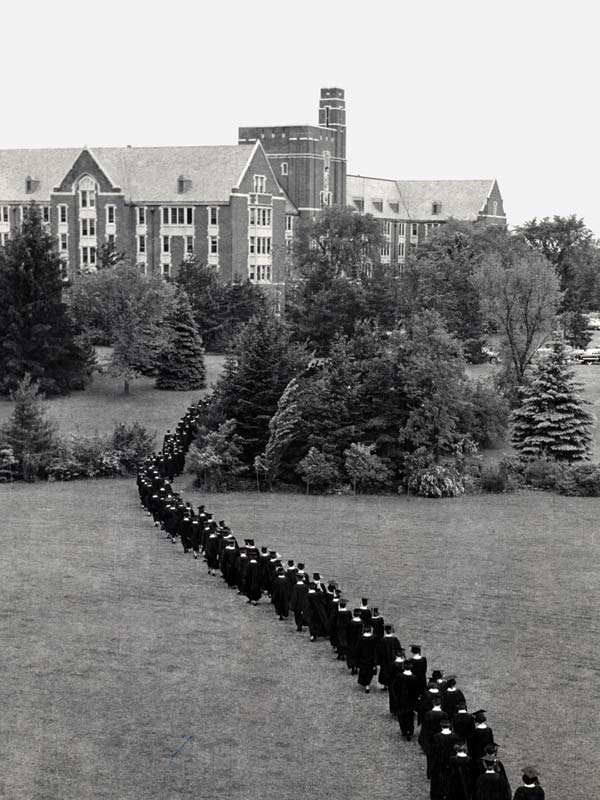Interfaith Ideas
Senior Celebration
Nazareth’s baccalaureate service has evolved along with the College
by Robyn Rime
Last year’s baccalaureate service at Nazareth included reflections from the Qur’an, a traditional Navajo prayer, a reading from the Sikh tradition, and blessings from leaders in the Jewish, Islamic, and Christian faiths.
It was not a traditional baccalaureate service. But it was very definitely a service reflecting the College’s multiple faith communities and the diverse character of Nazareth’s graduating seniors in 2012. And that, says Lynne Staropoli Boucher, director of the Center for Spirituality (CFS), is the point.
Baccalaureate, the religious celebration of commencement, has been a tradition on college campuses for centuries. “The intent, or mission, of the service hasn’t changed,” explains Boucher. “But the form has changed over the years to reflect the student population.”
Nazareth’s baccalaureate was originally a Catholic Mass, celebrated in Latin in the early days of the College, according to Marion Hoctor, S.S.J., Ph.D., former vice president for academic affairs and provost and professor emerita of English. The service was held both outdoors and in later years in the chapel at the Motherhouse of the Sisters of St. Joseph (now the Paul and Judy Linehan Chapel in the Golisano Academic Center).
By the 1970s, baccalaureate began to change shape, reflecting changes both on campus and throughout the Catholic world following the Second Vatican Council. Not long after Nazareth became an independent institution in 1971, the College hired its first Protestant chaplain, and baccalaureate became a service that blended both Catholic and Protestant elements. Readings by senior class officers and performances by Nazareth’s choirs and musical ensembles individualized the service from year to year, and homilies by the likes of Msgr. William H. Shannon, Ph.D., D.D., then chair of the religious studies department, grounded the ceremony in the Catholic tradition.
During the mid-1980s, a single religious service no longer represented the student population. Baccalaureate became two separate services, an interfaith service of the word held outdoors in a tent followed by a Catholic Mass in the chapel in the Shults Community Center. Catholic traditions were increasingly balanced with interfaith material, such as Jewish speakers and readings from the Wisdom of Sirach. “We were very thoughtful as we made changes,” explains Boucher. “We wanted to be as inclusive as possible.”
“For me and my classmates, the service worked, and we have wonderful memories of it,” says Jamie Fazio ’97, Nazareth’s current Catholic chaplain. With only a thousand students on campus—half the number of undergraduates that Nazareth has today—the student body was neither as large nor as diverse as it is now.
By 2001, the service changed form again, becoming the unified interfaith service that it remains today: a true blending of Catholic tradition with religious thinking from a broad range of faiths, from Jewish to Protestant, Hindu to Native American, Buddhist to Muslim. Baccalaureate today belongs to the students, explains Boucher. “We try to work with the students and have them take it, own it, feel it.” The content of the service is unique to the senior class, representing the mosaic of who they are and demonstrating their commonality amid diversity.
“I don’t consider myself a particularly religious person, and I didn’t feel out of place,” says Carly Maldonado ’12, who was a reader during last year’s service. “The religion isn’t gone from the ceremony, but the service feels welcoming to all students.”
“It’s been an evolution in our consciousness of what interfaith means,” says Boucher. “We began by thinking of everyone as a Catholic. Then we acknowledged not everyone was Catholic, and we included Protestants. The next stage was realizing not everyone was Christian. Now the cutting edge is to include people who are not religious and may not even be theists but who are still spiritual and who want to be included in a soulful and respectful way.”
The changes in baccalaureate haven’t gone unsupported. “I can’t put into words how much we’ve looked back to the sisters and Fr. Shannon and Kathy Weider [S.S.J., former director of the CFS],” says Boucher. “We want to do right by that legacy. We’ve checked in with them and used them as consultants, and they’ve supported that evolution.”
“Baccalaureate isn’t perfect, but it reflects the values of Nazareth and the sisters’ founding mission: connecting neighbor to neighbor and neighbor to God,” concludes Fazio. “Nazareth has changed, but that has always stayed the same.”
Robyn Rime is the editor of Connections.

In the 1950s, graduating seniors dressed in their commencement robes and processed to the Motherhouse for a formal celebration of Mass. Seniors celebrating baccalaureate nowadays also celebrate Nazareth's interfaith population.
Learn more about Nazareth’s Center for Spirituality at naz.edu/cfs